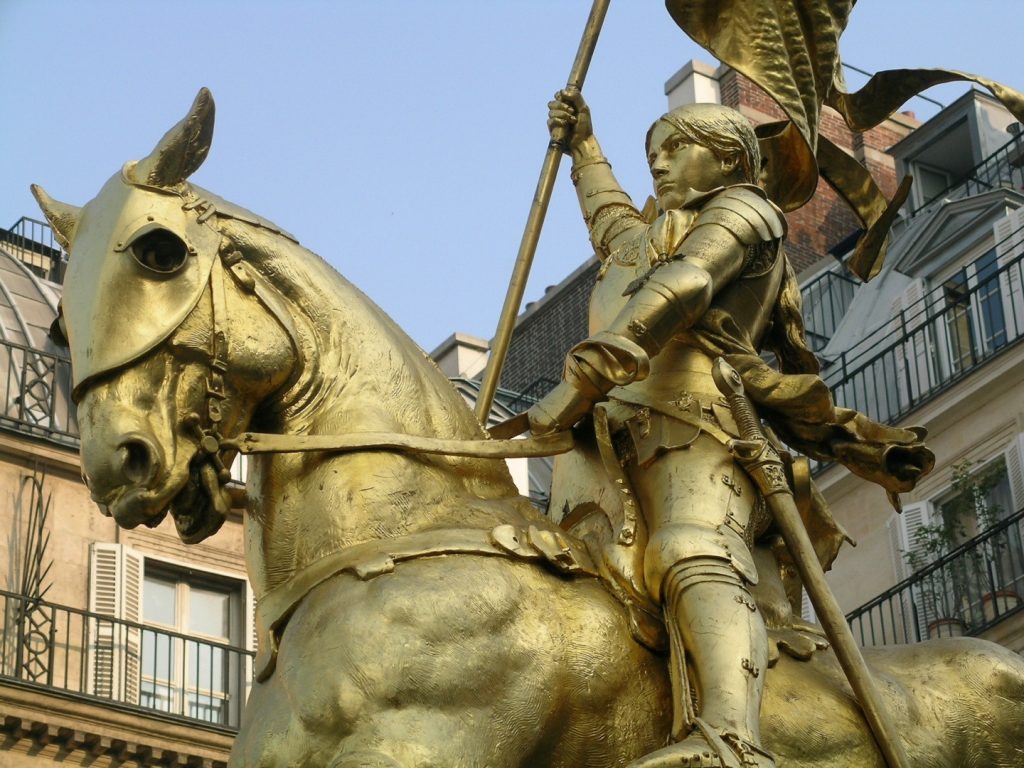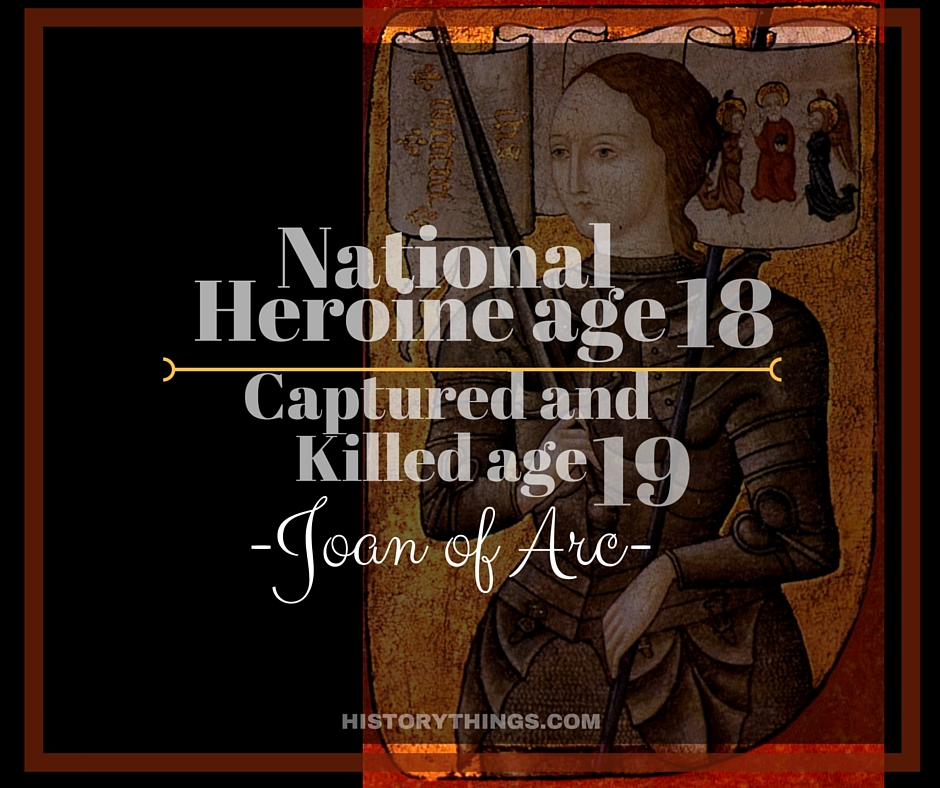
PHOTO: injoanofarcsfootsteps.com
“I must be at the King’s side … there will be no help [for the kingdom] if not from me. Although I would rather have remained spinning [wool] at my mother’s side … yet must I go and must I do this thing, for my Lord wills that I do so.”
– Joan of Arc
Last time on History’s Badasses, we covered the famous mountain-man and American badass, Hugh Glass, who, after being mauled by a grizzly bear and left for dead by his comrades, traveled 200 miles on foot alone in the American wilderness to safety at Fort Kiowa.
This time, we’ve got another huge badass for you. She was a national heroine and general at the tender age of eighteen – a young woman who believed that she was on a mission sent by God to lead the French army to victory over the British. Her name was Joan of Arc.
It was the 1400s. France was fighting a massive religious war against Britain, a war famously called the Hundred Years’ War, over a dispute about who was the true heir to the French throne.
In 1415, King Henry V invaded northern France. At the time, France was ruled by the insane King Charles VI. The English army quickly defeated the French and the Burgundians rose to their support. By 1420, the Treaty of Troyes was signed, declaring King Henry V regent over France. Henry was meant to inherit the throne of France after Charles died, effectively uniting France and Britain under one crown.
Unfortunately, both kings died shortly after the treaty was signed. That left English King Henry’s infant son in charge of both France and England. Well, that didn’t sit well with the French. Charles VI had a son too, aptly named Charles VII, and they thought he should be king.
War was, yet again, brewing between France and England. It was on this stormy horizon that our heroine first appeared.
Early Life
![Birthplace of Joan of Arc. [PHOTO: wikimedia]](https://historythings.com/wp-content/uploads/2016/08/1024px-Jeannedarcbirthplace-300x200.jpg)
Birthplace of Joan of Arc, now a museum. [PHOTO: wikimedia]
Joan was sixteen when the French declared Charles VII to be the Dauphin (heir) of the French throne. Right around this time, she started hearing voices and having visions. She took a vow of chastity, and talked her way out of an arranged marriage her father had put together for her. When asked about her mystical visions later, she said she was met by St. Michael and St. Catherine, who told her she was to be the savior and heroine of France, and that she ought to seek out the French Dauphin, fight to expel the English, and bring Charles VII to Reims for his coronation.
After her vision of St. Michael and St. Catherine, she asked a relative to take her to a nearby town, where she then went to the garrison commander, a man by the name of Robert de Baudricourt, for permission to audit the French Royal Court at Chinon. Of course, Baudricourt only gave her a snippy retort. She was just a teenage girl after all. Why should he trust her?
Joan would not be ignored. She arranged a second meeting with Robert, and it was there that she predicted French defeat at Rouvray. When messengers arrived to report it several days later, Joan’s prediction was confirmed. Robert was certain she could have only known about the defeat by Divine revelation, and so he believed her.
An Audience With the Dauphin
![Joan of Arc at the coronation of Charles VII [PHOTO: maidofheaven.com]](https://historythings.com/wp-content/uploads/2016/08/joanbakalowicz.jpg)
Joan of Arc at the coronation of Charles VII [PHOTO: maidofheaven.com]
When they arrived at Chinon, at first, Charles didn’t know how he felt about her. In order to test whether or not she really was a prophetess, he disguised himself and hid in the crowd of courtiers. Upon her arrival in court, Joan immediately identified him.
Joan impressed him further by telling him the details of a secret prayer he had prayed to God in a desperate attempt to ask for France’s deliverance from England. Still unsure, afraid of others thinking he had a witch or sorceress as a consort, Charles had Joan examined by local, prominent theologians, all who said Joan was “of irreproachable life, a good Christian, possessed of the virtues of humility, honesty and simplicity”.
Satisfied that she was not a witch and at his wits-end after facing defeat after defeat, Charles put his trust in the one last shining beacon of hope he had. He equipped Joan with a horse, white armor, and a sword, and rode for the besieged French city of Orleans to fight the English with her at his side.
Military Campaigns
Charles VII and Joan of Arc marched on Orleans in May of 1749. Joan was just 17. When the French troops stationed at Orleans heard Joan was there, the morale soared. They took control of the English fortifications and lifted siege. During the battle, Joan was wounded with an arrow but returned later to encourage the assault, spurring the French on to victory.
By June, the French had pushed the English back under Joan’s encouragement. The English armies no longer seemed invincible.
At another battle, at Jargeau, Joan was with French general Alençon. According to him, she saved his life by warning him about cannonball just in the nick of time. He moved out of the way of the shot, unscathed. Joan took a hit to the helmet with a rock, but was, amazingly, unharmed.
After the battles at Orleans and Jargeau, the English withdrew from the Loire Valley. Joan urged the French armies to pursue the English, and they did. The two armies met and clashed at Patay. Under Joan’s leadership, it was an immense strategic victory. The French vanguard slammed into the English archers, and the rest of the cavalry and infantry swooped down and decimated the English army and captured most of their commanders. The French army suffered minimal losses that day.
!["Entrance of Joan of Arc into Reims" by Jan Matejko [PHOTO: wikimedia]](https://historythings.com/wp-content/uploads/2016/08/1024px-The_Maid_of_Orléans.png)
“Entrance of Joan of Arc into Reims” by Jan Matejko [PHOTO: wikimedia]
After Charles was crowned king, the French army swiftly marched on Paris. They lay siege to the city on September 8th, with Joan at the front of the army. She took a crossbow bolt to the leg, but remained in the trenches, fighting and urging the troops on until a French commander came and carried her to safety.
Though that day the French did not take Paris, England later signed a truce to end the fighting, and the city was given over to French hands.
Capture and Trial
The truce didn’t last long. In May of 1430, the English-loyal Burgundians lay seige to Compiègne, breaking the truce. Joan rode out with the French forces at Charles’ command to defend the city, but was surrounded by Burgundians. With nowhere to run, the Burgundians yanked Joan off her horse and took her into custody.
![The tower where Joan was held prisoner. [PHOTO: wikimedia]](https://historythings.com/wp-content/uploads/2016/08/170px-Tour_Jeanne_DArc10.jpg)
The tower where Joan was held prisoner. [PHOTO: wikimedia]
The English knew that if they simply charged Joan with crimes against the English crown, the French would quickly rally to her rescue. So, instead, they tried her for heresy. There were other charges, too, charges that included witchcraft, sorcery, and cross-dressing.
They tried trying her publicly, but Joan behaved so well during these trials that she gained support. When that didn’t work, the English held her in a military prison, and threatened to rape and torture her. The story goes that she protected herself by tying the soldiers’ clothes together with dozens of cords.When nothing worked, the court eventually caught her on wearing a man’s armor, charging her with cross-dressing.
On May 29th 1431, the tribunal at Rouen charged Joan of Arc guilty of heresy. At this point, no French support was coming. Charles VII could not risk being associated with a heretic. If he supported her, he’d lose all of his allies, as they’d believe he won his crown through witchcraft and sorcery.
Joan of Arc was only nineteen, and she was completely alone.
Death and Legacy
Morning dawned on the 30th of May. Joan was pulled from her prison cell and taken out into the light, into the marketplace in Rouen where her pyre was waiting. An estimated 10,000 people watched as she was burnt at the stake. She was just nineteen years old.
Afraid of conspiracies and rumors, the English raked the ashes to expose her charred body so that everyone knew she was indisputably dead. After that, they burned her two more times to reduce her body to ashes, and then scattered those ashes in the Seine so that no religious relics could be made from her body.
The Hundred Years’ War would rage for 22 more years. Charles VII remained crowned King of France, and eventually he ordered an investigation led by Pope Callixtus III that eventually cleared Joan of all her charges and renamed her a martyr.
In 1920, she was canonized by the Catholic church as the patron saint of France.
Of Joan of Arc, biographer Stephen W. Richey wrote:
The people who came after her in the five centuries since her death tried to make everything of her: demonic fanatic, spiritual mystic, naive and tragically ill-used tool of the powerful, creator and icon of modern popular nationalism, adored heroine, saint. She insisted, even when threatened with torture and faced with death by fire, that she was guided by voices from God. Voices or no voices, her achievements leave anyone who knows her story shaking his head in amazed wonder.



![The interrogation of Joan of Arc. [PHOTO: wikimedia]](https://historythings.com/wp-content/uploads/2016/08/170px-Joan_of_arc_interrogation.jpg)
